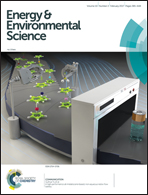Self-healing SEI enables full-cell cycling of a silicon-majority anode with a coulombic efficiency exceeding 99.9%†
Abstract
Despite active developments, full-cell cycling of Li-battery anodes with >50 wt% Si (a Si-majority anode, SiMA) is rare. The main challenge lies in the solid electrolyte interphase (SEI), which when formed naturally (nSEI), is fragile and cannot tolerate the large volume changes of Si during lithiation/delithiation. An artificial SEI (aSEI) with a specific set of mechanical characteristics is henceforth designed; we enclose Si within a TiO2 shell thinner than 15 nm, which may or may not be completely hermetic at the beginning. In situ TEM experiments show that the TiO2 shell exhibits 5× greater strength than an amorphous carbon shell. Void-padded compartmentalization of Si can survive the huge volume changes and electrolyte ingression, with a self-healing aSEI + nSEI. The half-cell capacity exceeds 990 mA h g−1 after 1500 cycles. To improve the volumetric capacity, we further compress SiMA 3-fold from its tap density (0.4 g cm−3) to 1.4 g cm−3, and then run the full-cell battery tests against a 3 mA h cm−2 LiCoO2 cathode. Despite some TiO2 enclosures being inevitably broken, 2× the volumetric capacity (1100 mA h cm−3) and 2× the gravimetric capacity (762 mA h g−1) of commercial graphite anode is achieved in stable full-cell battery cycling, with a stabilized areal capacity of 1.6 mA h cm−2 at the 100th cycle. The initial lithium loss, characterized by the coulombic inefficiency (CI), is carefully tallied on a logarithmic scale and compared with the actual full-cell capacity loss. It is shown that a strong, non-adherent aSEI, even if partially cracked, facilitates an adaptive self-repair mechanism that enables full-cell cycling of a SiMA, leading to a stabilized coulombic efficiency exceeding 99.9%.



 Please wait while we load your content...
Please wait while we load your content...